Mumuye people, Lagalagana figure, Adamawa Plateau, Muri Division of Adamawa Province, Nigeria
Pagina 1 di 1
 Mumuye people, Lagalagana figure, Adamawa Plateau, Muri Division of Adamawa Province, Nigeria
Mumuye people, Lagalagana figure, Adamawa Plateau, Muri Division of Adamawa Province, Nigeria
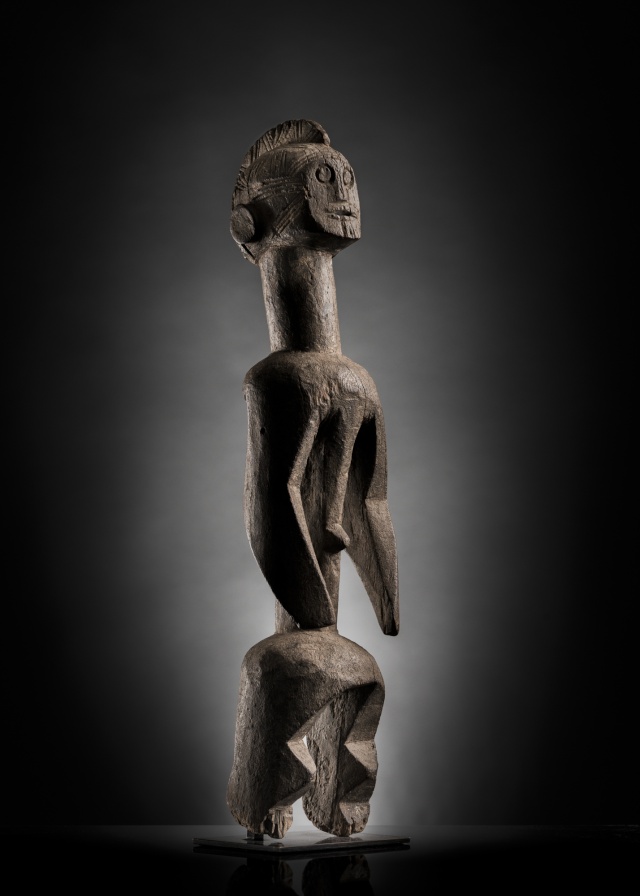
Mumuye people, Lagalagana figure, Adamawa Plateau, Muri Division of Adamawa Province, Nigeria
Wood with patina of long use, remains of kaolin, traces of red pigment.
H. 16.9 in. / 43 cm
Last quarter of the nineteenth century / Early twentieth century
Private collection Italy
Photo Courtesy of Fabio Cattabiani
Arti delle Mani Nere All Rights Reserved
Provenance
-Edouard Klejman coll. Paris ( probably)
-Michel Andrault Coll. Paris
-Alain de Monbrison Gallery, Paris
-Denise and Beppe Berna Gallery, Bologna
Exhibition
Antiquariato, XXVIII Mostra Mercato Nazionale, Villa Castelbarco, Vaprio d’Adda, Milano, October 18/26 2014
Published
Beppe Berna, ”Art Africain, Mumuyé. Une breve histoire, en images de la sculpture mumuyé”, Archivio Denise e Beppe Berna, Bologna
“ En 1962, une exposition au Museum of Primitive Art à New York, ainsi que le catalogue s’y rapportant, rédigé par Roy Sieber, suscitaient un vif intérêt pour les oevres des Igala et Idoma de la region jouxtant la confluence du Niger et de la Bénoué, et pour celles des Jaba, Goemai et Montol de la region s’étendant vers l’ouest de la Bénoué en partant de la ville d’Ibi.
Les oevres des Mumuye restaient inconnues en France jusqu’à l’automne 1968 (Melle Mette Bovin a exposé des oevres Mumuye au Danemark en 1965/66).
...Les peuple Mumuye habite le quadrilatère délimité au sud-est par les montagnes Chebchi, entre les rivières Fan Magna et Ini, au sud-ouest par le cours de la Fan, au nord-ouest par les plaines qui longent la rive sud-est de la Bénoué, et au nord-est par l’Ini. Les collines Mumuye, rocheuses et difficiles d’accès, s’élèvent entre Ganleri et Mayo Belwa dans la partie est du quadrilatère; entre Sawa, Zinna et Jarang et au long des rivières le terrain s’aplatit pour céder place à la savane". (Philip Fry, 1970)

At the end of the 1960’s, the anarchy caused by the Ibo war of secession in the south of Nigeria, along with the abandonment of religious practices, caused a surge of the traditional Nigerian works of art onto the art market. The first exhibition of Mumuye figures in France was organized at the Majestic Gallery in 1968 by Michel Huguenin and Edouard Klejman. At the same time, Philippe Guimiot and Jacques Kerchache also made significant contributions to the recognition of Mumuye statuary. (Courtesy of Sotheby's, 2008)
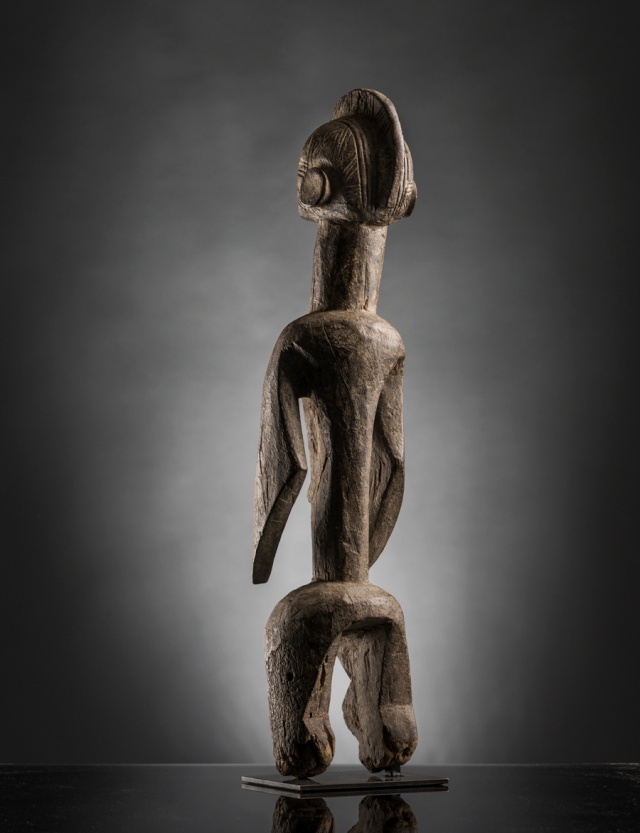
In addition to use in shrine contexts, Mumuye figures also were used in curing and divination contexts.
"The sculpture is portrayed standing; the plastic volumes are rigorous, sober, almost austere, with the exception of the head which presents an accurate execution of both features and traditional scarification.
The face, slightly turned upwards, evokes the attitude of certain sculptures Montol (rif: healer figure collected by Roy Sieber in 1958 and now in Indiana University Art Museum, Bloomington).
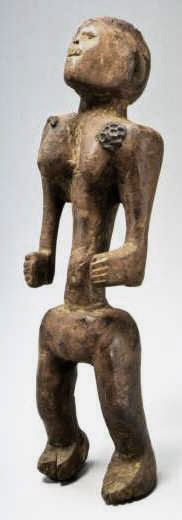
Courtesy Yale Universit Art Gallery
Le style de la statue est très ancien et très puissant. Une autre statue Mumuye qu'elle provient de l’artiste et grand collectionneur allemand Fritz Koenig, (ex Lucien van de Velde Gallery), est probablement de la même main. Le même atelier (et peut-être de la même main), c' est aussi celui qui a fait le grand masque-heaume (cm 95) appartenant à une collection privée française. Ils sont parmi les plus anciens spécimens a avoir été collectés a la fin des années 1960.
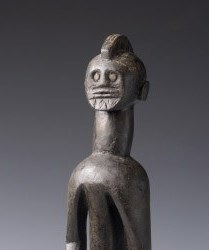
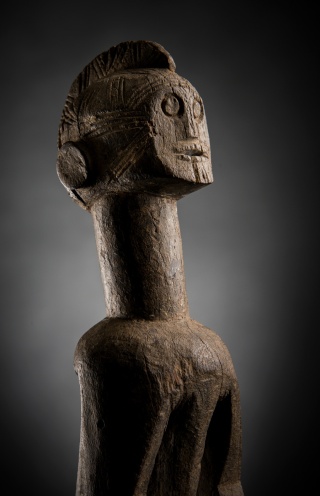

Fritz Koenig coll. et masque-heaume, coll. privée française.
Despite the absence of sexual characterization, it's possible to identify a male figure, thanks to the presence of "crested" hairdressing and for coloring, originally red (black for female ones), become grayish over time.
Stylistically, the work belongs to the small group of specimens ascribed to the "Masters of the British Museum" that anticipated the "discovery" of art Mumuye.

Of the same type are those collected by E.S. Lilley in 1921 (female sculpture, h. 48 cm) and that collected by Roy Sieber in 1958 (male figure, h. 57 cm), together with that of the collection Leon Lippel (h. 45 cm), exposed at Flak Gallery, Paris in 2012 (Nigeria. Les maitres du mouvement. Masters of movemet)".
(Beppe Berna)



Mumuye E.S.Lilley, Mumuye R. Sieber and Mumuye L.Lippel, courtesy Yale Universit Art Gallery and Flak Gallery

Gall. Bernard Dulon, cm 57, Collection Alain Javelaud
Mumuye people, Lagalagana figure, Adamawa Plateau, Muri Division of Adamawa Province, Nigeria

Legno a patina chiara di lungo uso, resti di caolino, tracce di rosso
H. 16,9 in./ cm 43
Ultimo quarto XIX sec/ Primi XX sec
Collezione privata, Italia
Foto di Fabio Cattabiani
Arti delle Mani Nere All Rights Reserved
Provenienza
–Coll. Edouard Klejman, Paris (probabilmente)
- Coll. Michel Andrault, Paris
- Galleria Alain de Monbrison, Paris
- Galleria Denise e Beppe Berna, Bologna
Esposizioni
Antiquariato, XXVIII Mostra Mercato Nazionale, Villa Castelbarco, Vaprio d’Adda, Milano, 18/26 ottobre 2014
Pubblicazioni
Beppe Berna, ”Art Africain, Mumuyé. Une breve histoire, en images de la sculpture mumuyé”, Archivio Denise e Beppe Berna, Bologna
“Nel 1962, un'esposizione al Museum of Primitive Art di New York, così come il catalogo ad essa collegato, redatto da Roy Sieber, ha suscitato un vivo interesse per l’arte degli Igala e degli Idoma della regione circostante la confluenza del Niger e del Bénoué, e per quelle dei Jaba, Goemai e Montol della regione che si stende verso l'ovest del Bénoué partendo dalla città di Ibi.
Le opere dei Mumuye sono restate pur tuttavia sconosciute in Francia fino all'autunno 1968.( Esposte invece in Danimarca nel 1965/66 a cura di Melle Mette Bovin)
….La popolazione Mumuye è stanziata nel quadrilatero delimitato a sud-est dalle montagne Chebchi, tra i fiumi Fan Magna ed Ini, a sud-ovest lungo il corso del Fan, a nord-ovest dalle pianure che costeggiano la riva sud-est del Bénoué, e a nord-est dal fiume Ini. Le colline Mumuye, rocciose e difficilmente accessibili, si alzano tra Ganleri e Mayo Belwa nella parte est del quadrilatero; tra Sawa, Zinna e Jarang e lungo i fiumi la terra si appiattisce e cede il posto alla savana."(Philip Fry,1970)
Alla fine dei 1960, l'anarchia causata dalla guerra di secessione degli Igbo nel sud della Nigeria, insieme all'abbandono di pratiche religiose, provocò un afflusso sul mercato di manufatti di arte tradizionale nigeriana. La prima esposizione delle figure di Mumuye in Francia fu organizzata alla Galleria Majestic nel 1968, a cura di Michel Huguenin ed Edouard Klejman. Negli stessi anni, Philippe Guimiot e Jacques Kerchache valorizzarono con significativi contributi il riconoscimento della statuaria Mumuye. (Courtesy of Sotheby 2008)
Lo stile della statua è molto arcaico e molto potente. Un' altra statua Mumuye che proviene dalla raccolta del grande artista e collezionista tedesco Fritz Koenig, (ex Lucien Van de Velde Gallery), è probabilmente dello stesso atelier. Lo stesso atelier e forse la medesima mano, è anche quella che ha realizzato la grande masque-heaume (cm95) appartenente ad una collezione privata francese ( Côté et Lebas, 2012). Sono tra i più antichi esemplari collezionati alla fine degli anni '60.
Oltre ad una valenza sacro/religiosa, le figure Mumuye erano utilizzate anche in contesti di guarigione e nei rituali di divinazione.
"La scultura è ritratta in posizione eretta secondo volumi plastici rigorosi, sobri, quasi austeri, con la sola eccezione della testa che presenta un’accurata esecuzione sia dei lineamenti, sia delle scarificazioni tradizionali.
Il viso, leggermente rivolto verso l’alto, evoca l’atteggiamento di certe sculture Montol (cfr.: la figura di guaritore raccolta da Roy Sieber nel 1958 ed appartenente all’Indiana University Art Museum di Bloomington).
Pur in assenza di caratterizzazione sessuale, si identifica con certezza una figura maschile in ragione della presenza dell’acconciatura “a cresta” e della coloritura, originariamente rossa (nera per quelle femminili), divenuta nel tempo di color grigio.
Sul piano plastico, l’opera appartiene al ristretto nucleo di esemplari ascrivibili ai “Maestri del British Museum” che hanno anticipato la “scoperta” dell’arte Mumuye.
Della medesima tipologia sono l’esemplare raccolto da E.S.Lilley nel 1921 (scultura femminile, H. cm 48) e quello raccolto da Roy Sieber nel 1958 (figura maschile, H. cm 57), unitamente a quello della coll. Leon Lippel di 45 cm, esposto alla Galleria Flak a Parigi, nel 2012 ( Nigeria. Les maitres du mouvement. Masters of Movemet)".
(Beppe Berna)
Bibliography
-TEMPLE O. and C.L., Notes on the Tribes, Provinces, Emirates and States of the Northern Provinces of Nigeria, Lagos, CMS Bookshop, 2è éd.,1922.
-MEEK C.K., The Northern Tribes of Nigeria, 2 vols, Londres,1925-31
-SIEBER Roy, Sculpture of Northern Nigeria, New York, 1966.
-SIEBER Roy, Interaction: the art styles of the Benue River Valley and East Nigeria, Bloomington, 1970.
-FRY Philippe, Essai sur la statuaire Mumuye, Objets et mondes, X, 1, 3-28,1970.
-KERCHACHE Jacques, Les arts premiers de l’Est nigérien dans Connaissance des Arts, n°285, novembre 1975.
-MOEYERSONS Jan, Joint patterns and their influence on the granitic residuals in N.E. Nigeria, dans revue Z. Geomorph. N. F., 21,1, p. 14 – 25, Berlin-Stuttgart, Mars 1977.
-DREWAL H.J., Traditional Art of the Nigerian Peoples, the Ratner Collection, Washington D.C., 1977.
-RUBIN Arnold Gary, Figure Mumuye dans Vingt Cinq Sculpures africaines, ed. J. Fry, Musées Nationaux du Canada, 1978
-WITTMER Marcilene & ARNETT William, Three Rivers of Nigeria, Atlanta, 1978.
-JONES, G. I., The art of Eastern Nigeria, Cambridge, 1984.
-NEYT François et DESIRANT Andrée, Les arts de la Benue. Aux racines des traditions, Tielt, 1985.
-HERREMAN Frank, De Wenteling om de aslijn Mumuye-beeldhouwwerken uit Nigeria,manuscrit, mars 1985, Waasmunster
-BERNS Marla, The essential gourd : art and history in northeastern Nigeria, L.A., 1986
-RUBIN Arnold Gary, Artists and Workshops in Northeastern Nigeria dans Iowa Studies in African Art, vol. II, University of Iowa, 1987.
-STRYBOL Jan, Les Mumuye, p. 235-240 dans " Arts du Nigeria. Collection du musée des Arts d'Afrique et d'Océanie, Paris: Réunion des Musées Nationaux, 1997:235-240
-Arts du Nigeria, Collection du Musée des Arts d’Afrique et d’Océanie, Exposition et Catalogue, 22 avril – 18 août 1997, Paris.
-STRYBOL Jan, Peuplement, habitat et structures agraires au Sud de la Benué : le cas du pays Mumuye, Peeters,Paris, 1998.
-BERNS Marla, FARDON Richard, Le Bassin supérieur de la Bénue et les hautes terres, p. 218-222 dans Arts du Nigeria, 2001.
-EVERS Christophe, Art of the Upper Benue River, Bruxelles, 2003.
-Neyt (François), "Mumuye”, Paris: Galerie Flak, 2006
-BERNS Marla, FARDON Richard, Central Nigeria unmasked : arts of the Benue River Valley, L.A., 2011.

 Argomenti simili
Argomenti simili» Igbo people, Ntekpe figure, Northeast Cross River, Nigeria
» Makonde people, Diviner's Horn (Féticheur), Mtete, Mueda plateau, southeast Tanzania and northern Mozambique
» Dan Gio people, Female Figure, "Lü Mæ", Liberia/Guinea
» Agni people, Maternity Figure, Ivory Coast
» Songye people, N'kisi figure, Region of Eki or Beneki, Congo
» Makonde people, Diviner's Horn (Féticheur), Mtete, Mueda plateau, southeast Tanzania and northern Mozambique
» Dan Gio people, Female Figure, "Lü Mæ", Liberia/Guinea
» Agni people, Maternity Figure, Ivory Coast
» Songye people, N'kisi figure, Region of Eki or Beneki, Congo
Pagina 1 di 1
Permessi in questa sezione del forum:
Non puoi rispondere agli argomenti in questo forum.
 Indice
Indice